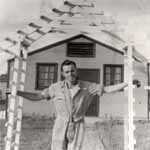Day Room remembered

McCook residents were asked to search their attics and spare rooms for furniture and furnishings "to provide comfort and recreation for our soldiers at the Air Base."
Pictured this week is Ed Hering of New Jersey, standing in front of Building T-51, one of two "day rooms" at the McCook Army Air Base built during the first phase of construction. Ed was with the 520th Base Unit (Overseas Training Unit) stationed at the McCook Army Air Base from August 1943 to May 1944. He worked in the base armament shop where they worked on 50-caliber machine guns used for the base firing range. He eventually was sent with the 501st to Guam from where Eagle B-29s were sent on missions to take out Japanese petroleum operations.
Recently I talked to Ed from his home in Linden, N.J. Dale Cotton had called him to ask some questions and told him that he had given me this photo of him in front of the day room ... so Ed called me. Ed said that the photo was taken because they had just planted a small tree in front of the building, within the white picket fence.
The day room opened about 9 o'clock in the morning and Ed doesn't remember it ever closing. Men could read, or write letters, play cards ... just relax and get together. It was really cold here the day I talked to Ed so I asked him how bad it was in those barracks out there on days like this with the wind blowing. Not too bad, Ed said. With a natural gas stove burning and 25 men sleeping on each side of the building, it was tolerable. He was only 18 years old at the time and single so the barracks and the base met most of his needs. Ed did remember coming into McCook and going to the Fox Theatre.
He remembered Alex Gochis at the Olympia and the good things to eat there and although he called it the BonTon, he remembered the nice Greek man.
Going home on leave meant making reservations on the Zephyr and waiting at the McCook depot. The last time Ed was in McCook he went down and just sat on the massive oak benches to reminisce about those train trips home. That's been a while ago because I told him he couldn't do that anymore.
Our big beautiful oak waiting benches now grace the inside of the Holdrege depot and the High Plains Museum in McCook. Ed said they always reminded him of church pews. BN said that they were too comfortable though, and encouraged loitering so replaced them with plastic tables and chairs. No loitering now! The depot is still beautiful though, with the vaulted ceiling and many of the architectural features still intact.
One of the most exciting things that he remembers happening at the McCook Air Base was a tornado. They took shelter in an irrigation ditch, actually more inside the culvert, and he remembers the ice that covered it. Our ice/hail impressed him. The many broken windows in the hangars that Ed remembered could have come from either the hail or the tornado.
Hering and another kid were taking trucks to Fort Riley one day and seeing all the sights on the way down and back.
While eating in a restaurant in Phillipsburg, Kan., they met two girls and started to date them. I asked how on earth he got back and forth to Phillipsburg from the base.
Hitchhiking! I had forgotten how much of that was done, especially during the war. Ed dated that girl three years but she ended up marrying someone else and sending him an invitation to the wedding. The last he knew she was living in Beaver City, Neb. So if Betty Marler Kay is still out there somewhere, let me know. Even Ed's wife wants to meet this one!
To fill the soldier's time on base, though, the day room was important. There were many articles in the Gazette about collecting items to furnish them with. A large ad of Feb. 20, 1943, headlined "What You Can Do to Provide Comfort and Recreation for Our Soldiers at the Air Base." The government did not provide furniture or equipment for use in the recreation rooms (day rooms) at the air base centers.
They needed the following items: eight davenports and lounges; two radios; 20 reading lamps; 10 magazine racks; 10 chairs (upright & rockers); 20 ash trays (with stand); 20 card tables; 20 writing desks; two pianos and some rugs.
Art Herrmann was chairman of the committee to obtain donations. The others were: Mrs. J.W. Hasty, Woman's Club; Ray Search, Kiwanis; Ben F. Hormel, Rotary club; Fred Marsh, Jr. Chamber of Commerce; William A. Hanke, American Legion; Harvey Lofton, Elks club; and Mayor L. Kleven, City of McCook. Since household items were scarce in McCook because of the huge influx of new people moving into temporary housing, the whole area was scoured for donations.
Local contacts in area towns were many times the American Legion Post Commanders.
